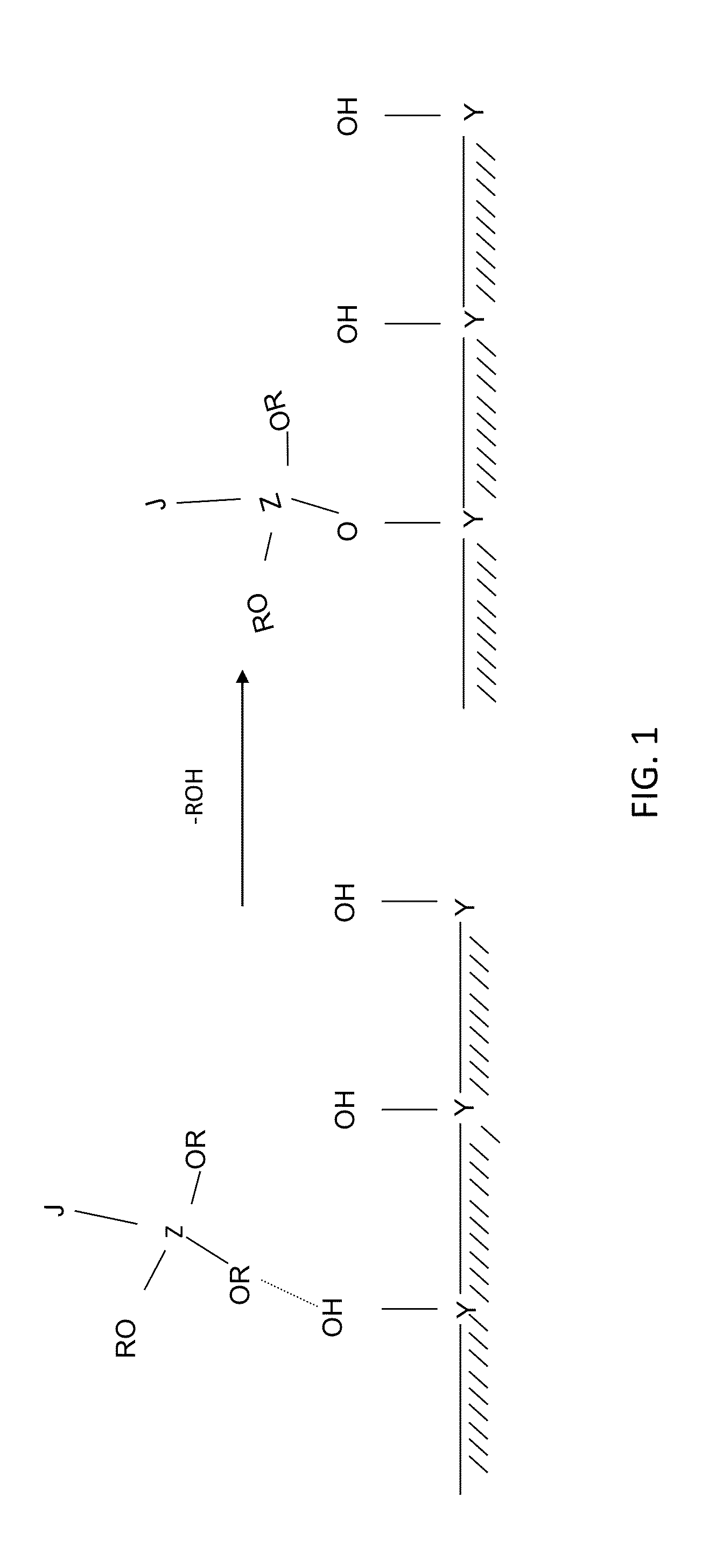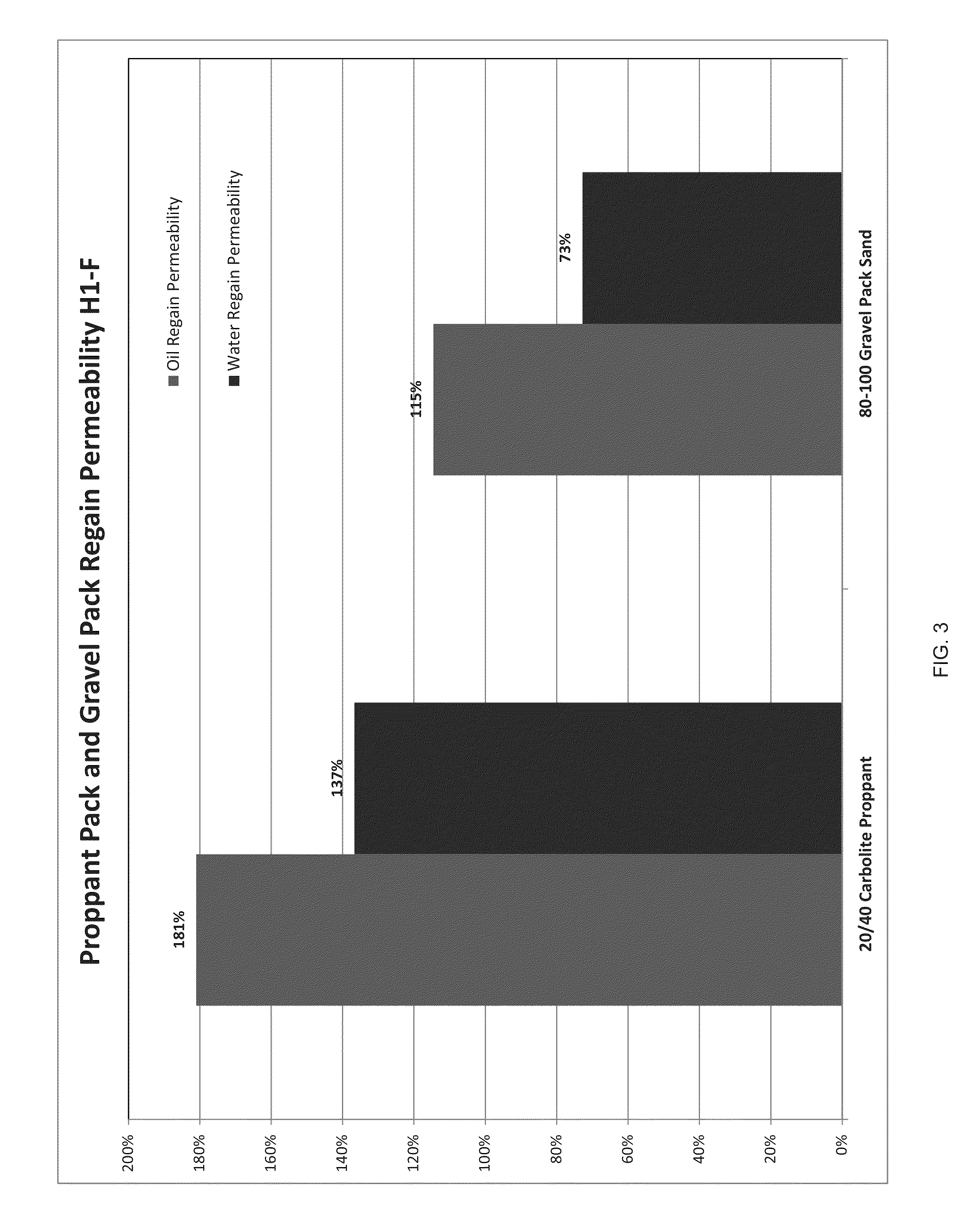Composites for use in stimulation and sand control operations
a technology of composites and sand control, applied in the direction of fluid removal, well accessories, chemistry apparatus and processes, etc., can solve the problems of reducing not being able to develop a specific method specifically designed to reduce the release of proppant dust, and reducing the amount of fines. , to achieve the effect of preventing the migration of sand, reducing the amount of fines, and reducing the damage of the proppant pack
- Summary
- Abstract
- Description
- Claims
- Application Information
AI Technical Summary
Benefits of technology
Problems solved by technology
Method used
Image
Examples
example 1
[0191]Permeability testing was performed on synthetic cores composed of 20-40 Carbolite proppant and 80-100 mesh silica sand. Each of the synthetic cores was 1.0″ in diameter and 2.0″ in length and having nitrogen permeability of 100 and was saturated with ISOPAR™ paraffinic fluid. Each of the cores was then installed in a hydrostatic core holder apparatus and tested individually. Approximately 200 psi back pressure was applied at the exit end and approximately 1,000 psi confining stress (overburden pressure) was applied around the entire cylinder. The confining stress pressure simulates stress in the downhole formation. An aqueous solution of 2% potassium chloride (KCl) was then flowed through the core in order to establish baseline permeability to the water at residual oil saturation. Following establishment of baseline water permeability, ISOPAR™ paraffinic fluid was flowed through the core until a baseline permeability to oil was established at irreducible water saturation. Pres...
example 2
[0195]Gel recovery in proppant / gravel pack was determined by weighing one kilogram of particles, than packing them in a 12 inches long, 2 inches in diameter column. Three liters of deionized water, followed by two liters of linear gel (40 ppt, lb per thousand gallon,) HEC and 3 liters of water were run through the pack. The differential pressure was recorded and used to calculate the percent permeability.
[0196]Three sample were tested: (1) silica sand (control frac sand); (2) E-modified silica sand (E-Mod Frac Sand) and (3) H1-F modified silica sand (H1-F Mod Frac Sand). The surface modified silica sand were prepared by mixing the sand with the solution containing the surface treatment, mixing for about five minutes than drying in an oven overnight at 150° F. The samples were cooled down before use.
[0197]Permeability recovery in the proppant / gravel (treated and untreated) after exposing the pack to water, linear gel and then water is illustrated in FIG. 4.
[0198]The methods that may ...
example 3
[0199]White Northern Sand, commercially available from Unimin Corporation, having a size of 20 / 40 mesh (proppant) was modified using three surface modifying treatment agents. Each of the surface modifying treatment agents, available from Aculon, Inc., had a hydrophobic tail and an anchor. The surface modifying treatment agents may be identified as H1-F and Aculon E [comprising 2% of a treatment agent having a transition metal (anchor) linked to a fluorinated hydrocarbon tail in an organic solvent] and AL-B [comprising 2% of an organophosphonate (anchor) having a hydrocarbon polymeric hydrophobic tail in an organic solvent blend]. Aculon-E and AL-B exhibits hydrophobic and oleophobic properties while H1-F exhibits hydrophobic properties only. 1.5 kg of sand was mixed with the surface modifying treatment agent for 5 minutes at room temperature. Coating of the surface modifying treatment agent onto the surface of the proppant proceeded by self-assembly of monolayers. Such self-assemble...
PUM
| Property | Measurement | Unit |
|---|---|---|
| temperature | aaaaa | aaaaa |
| temperatures | aaaaa | aaaaa |
| pressures | aaaaa | aaaaa |
Abstract
Description
Claims
Application Information
 Login to View More
Login to View More - R&D
- Intellectual Property
- Life Sciences
- Materials
- Tech Scout
- Unparalleled Data Quality
- Higher Quality Content
- 60% Fewer Hallucinations
Browse by: Latest US Patents, China's latest patents, Technical Efficacy Thesaurus, Application Domain, Technology Topic, Popular Technical Reports.
© 2025 PatSnap. All rights reserved.Legal|Privacy policy|Modern Slavery Act Transparency Statement|Sitemap|About US| Contact US: help@patsnap.com



